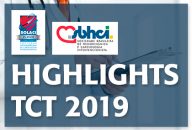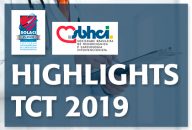In the next days, Dr. Seung Hun and colleagues will publish in J Am Coll Cardiol Intv 2019 a study that answers the title question and also brings peace of mind about the decisions we make based on one of these measurements or the other. This study assessed the physiologic characteristics of discordant lesions between…
TCT 2019 | PCI in Stable CAD. Prior TAVR, with TAVR or Never?
Courtesy of SBHCI. This interesting study presented at TCT 2019 and simultaneously published in Am J Cardiol tells us PCI in stable coronary artery disease cannot lower risk in patients with severe aortic stenosis undergoing transcatheter aortic valve replacement (TAVR). Unless patients are symptomatic, most coronary artery lesions do not need revascularization according to researchers.…
TCT 2019 | IVUS-XPL: 5-Year Follow-up for Angiography-vs. IVUS-Guided Angioplasty
Courtesy of SBHCI. The aim of this work, which was presented during the TCT 2019 Scientific Session and simultaneously published in JACC Intv, was to prove the benefit of intravascular ultrasound (IVUS) in angioplasty. The IVUS-XPL trial randomized 1400 patients with long coronary lesions (≥28 mm) to IVUS-guided angioplasty (n = 700) vs. angiography-guided angioplasty (n = 700). All procedures were…
TCT 2019 | FORZA: OCT vs FFR to Define Intermediate Lesions: Anatomy or Function?
Courtesy of SBHCI. Both fractional flow reserve (FFR) and optimal coherence tomography (OCT) can be useful to help define intermediate coronary lesions and optimize PCI outcomes. The FORZA study presented at San Francisco TCT 2019 scientific sessions simultaneously published in JACC randomized patients with intermediate lesions 1:1 to FFR vs OCT. For the FFR arm,…
Best Conduits and Best Surgeons for the Best Outcome
Myocardial revascularization surgery is still one of the most effective treatment strategies against coronary disease. One of the most important advantages of surgery over angioplasty is the chance to reach complete revascularization. This has proven to improve the survival of patients and to reduce the number of cardiovascular events. The choice of conduit for the…
ESC 2019 | CLARIFY: Symptoms Predict Risk Only in Patients with Prior MI
The 5-year follow up of patients with chronic stable angina (or as the guidelines currently call it “chronic coronary syndrome”) indicate the risk of cardiovascular death or non-fatal MI is quite low, but risk factor control is still fairly poor. This information comes from the CLARIFY study, presented at ESC 2019 and published simultaneously in…
ESC 2019 | Pure: Body Mass Index Shows Low Correlation with Cardiovascular Events
This population study has found all-cause mortality is lower the lower body mass index (BMI) is, but lower BMI is not necessarily better. In fact, the lowest mortality in this global analysis was found in patients with medium BMI. Other anthropometric measurements such as hip/waist ratio and strength/weight ratio are better predictors of events and…
ESC 2019 | SYNTAXES: Ten-Year Outcomes!
The SYNTAXES (SYNTAX Extended Survival) was presented at ESC 2019 with somewhat unexpected results in favor of PCI. This is why the SYNTAX continues to be one of the best studies interventional cardiologists can rely on. The original SYNTAX tested mortality (primary end point) with PCI vs. CABG in patients with multivessel and/or left main…
ESC 2019 | New European Guidelines on “Chronic Coronary Syndromes”
In Paris, during the European Society of Cardiology (ESC) Congress 2019 Scientific Sessions, new guidelines for the diagnosis and treatment of chronic coronary syndromes were presented. This document, simultaneously published in Euro Heart J, updates the 2013 guidelines on stable ischemic heart disease and takes out the word “stable” so as to emphasize that the…
Mechanisms of Post PCI Persistent Angina
Angina persistence or recurrence after PCI can affect between 20 to 40% of patients in the short and mid-term. This might be true despite PCI optimization using FFR, intravascular ultrasound and the latest generation stents. This problem is associated with high healthcare cost, which can double in patients with recurrent or persistent angina compared against…
Can Antiplatelet Therapy Affect the Life of Coronary Grafts?
The antiplatelet treatment strategy providing optimal balance between thrombotic and bleeding risks in patients undergoing myocardial revascularization surgery is unclear. What does seem somewhat certain is that some antiplatelet therapy is necessary to prevent early thrombosis, mainly in vein grafts, but (as opposed to what happens with angioplasty) there are other relevant factors such as…









